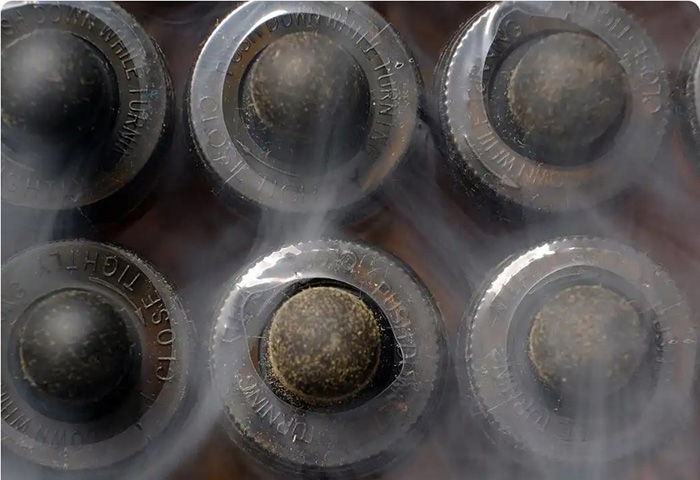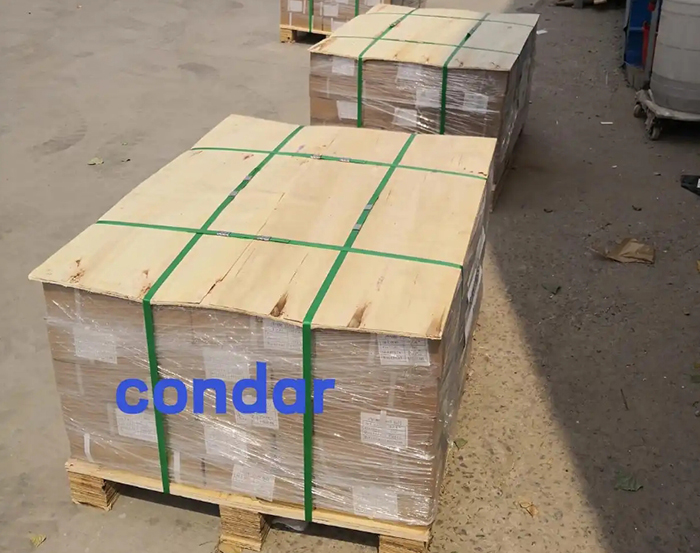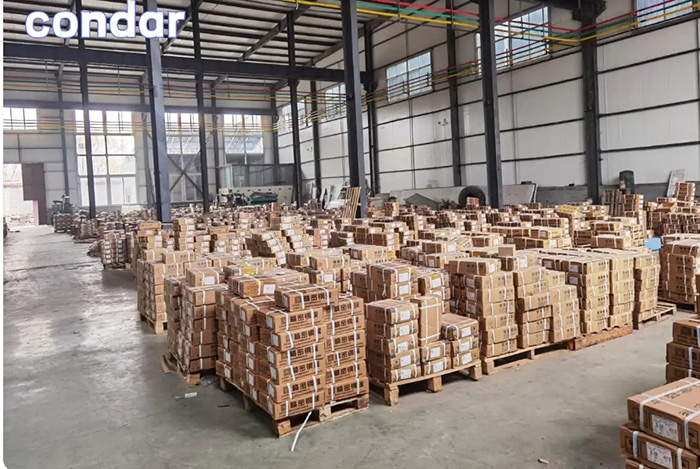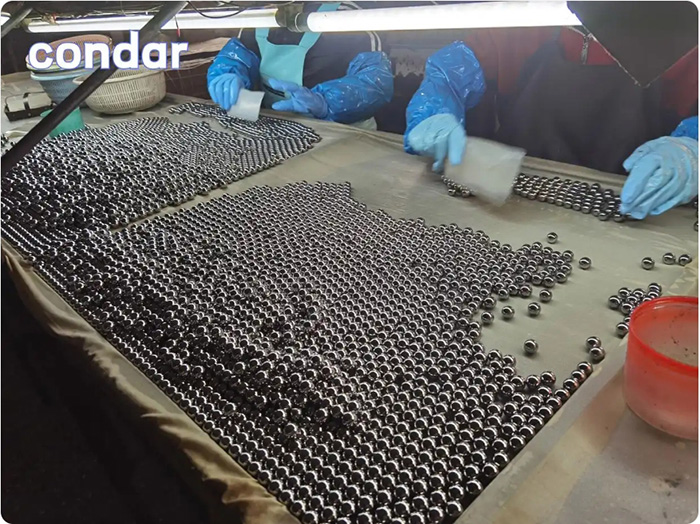In industrial production and daily life, steel balls, as a common mechanical component, are widely used in various fields such as hardware, machinery, bearings, auto parts, grinding, valves, sandblasting, and more. However, the issue of steel ball rusting has always been one of the key factors affecting its performance and service life. Rusting not only reduces the hardness and wear resistance of steel balls but may also lead to equipment malfunctions, increasing maintenance costs. Therefore, addressing the issue of steel ball rusting is particularly important.

Today, Condar Steel Balls will delve into the classification of steel ball materials, exploring which types of steel balls are resistant to rust and which are prone to rust. Based on this exploration, we will propose rust prevention strategies specifically for non-rust-resistant steel balls, covering multiple aspects such as packaging and storage, usage, assembly, and environment.
1、Steel ball material and rust resistance
Steel ball material that is resistant to rusting
1. Stainless steel balls; Stainless steel contains a certain amount of chromium, nickel and other elements, forming a dense oxide film that can effectively resist the erosion of oxygen, water and other corrosive media in the air. Therefore, stainless steel balls have good rust prevention performance. Especially stainless steel grades such as 304 and 316 are widely used in applications that require long-term corrosion resistance.
2. Alloy steel balls; Some alloy steels have improved their corrosion resistance by adding alloying elements such as chromium, molybdenum, nickel, etc. For example, tungsten steel balls and high chromium alloy steel balls can maintain good rust prevention ability in harsh environments and are suitable for high temperature, high pressure, and corrosive media environments.
3. Electroplated steel balls; By coating the surface of the steel ball with a layer of anti rust material (such as zinc plating, chrome plating, nickel plating, copper plating, etc.), the direct contact between the steel ball and the corrosive medium can be effectively isolated, thereby improving the anti rust performance. Electroplated steel balls are widely used in fields such as hardware, wrought iron, automobiles, household appliances, toys, etc.
Steel ball material that is not rust proof and prone to rusting
1. Ordinary carbon steel balls; Steel balls made of ordinary carbon steel have a simple chemical composition and lack sufficient alloying elements to form a protective oxide film, resulting in poor rust prevention ability. It is highly prone to rusting in humid, acidic, and alkaline environments.
2. Bearing steel balls; Although GCr15 bearing steel contains chromium and has a certain anti rust effect, the chromium content is too low, only about 1.5%, and the Cr content must exceed 13% to have a good anti rust effect. The Cr element in bearing steel GCr15 is mainly used to improve the mechanical properties of the steel, rather than for rust prevention.
3. Low alloy steel balls; Although it contains a small amount of alloying elements, the content is not sufficient to form an effective anti rust layer, and the anti rust performance is limited, making it suitable for occasions with low anti rust requirements.

2、 Rust prevention strategy for non rust resistant steel balls
Packaging And Storage
1. Sealed packaging: Use moisture-proof, dust-proof, and corrosion-resistant packaging materials such as plastic bags, aluminum foil bags, or vacuum bags to seal and package steel balls to reduce contact with air, moisture, and corrosive substances.
2. Desiccant usage: Place an appropriate amount of desiccant, such as silica gel, calcium chloride, etc., inside the packaging to absorb moisture and maintain a dry environment.
3. Storage environment: Choose a dry, ventilated, and dark warehouse to store steel balls, avoiding prolonged exposure to moisture, high temperatures, or corrosive environments.

1. Regular lubrication: During the use of steel balls, apply an appropriate amount of rust proof oil or lubricant regularly to form a protective layer and reduce friction and corrosion.
2. Cleaning and maintenance: Before and after use, the steel ball should be thoroughly cleaned to remove impurities such as oil and dust on the surface, avoiding pollutants from becoming the starting point of corrosion.
3. Regular inspection: Regularly inspect the surface condition of the steel ball. Once rust is found, it should be dealt with immediately to prevent the spread of rust.
Assembly and Environment
1. Choose appropriate assembly materials: During the assembly process, choose materials that are compatible with steel balls and not prone to corrosion, such as stainless steel, copper alloys, etc.
2. Improve working environment: For harsh working environments such as high temperature, humidity, corrosive gases, etc., effective measures should be taken, such as installing dehumidifiers, using corrosion-resistant coatings, etc., to improve the working environment and reduce corrosion risks.
3. Reasonable structure design: In product design, consider the stress situation and working environment of the steel ball, design a reasonable structure to avoid stress concentration and corrosion medium retention, and improve the rust prevention ability of the steel ball.

3、 Case analysis and practical suggestions
Case Analysis
During the production process, a certain automotive parts manufacturer discovered that the ordinary carbon steel balls they used had corroded shortly after assembly, resulting in a decrease in the performance of automotive parts and an increase in customer complaints. After analysis, it was found that it was due to excessive humidity in the warehouse and insufficient sealing of the steel ball packaging. In response to this issue, the manufacturer has taken the following measures:
-Dehumidify the warehouse to maintain a relative humidity below 60%.
-Use aluminum foil bags with better sealing performance for packaging, and place desiccants inside the bags.
-Clean and oil the steel balls before assembly.
After implementing the above measures, the problem of steel ball rusting has been effectively solved, and the product quality and customer satisfaction have significantly improved.
Practical suggestions
1. Material selection: In the design and material selection stage, steel ball materials should be reasonably selected based on the usage environment and rust prevention requirements, with priority given to stainless steel, alloy steel, or coated steel balls.
2. Standardization of packaging and storage: Develop unified packaging and storage standards to ensure that steel balls are not corroded during storage and transportation.
3. Establish a rust prevention management system: Establish a steel ball rust prevention management system, clarify rust prevention measures, inspection cycles, and responsible persons to ensure effective implementation of rust prevention work.
4. Training and publicity: Strengthen the training of employees on rust prevention knowledge and enhance their awareness of rust prevention; At the same time, through brochures, posters, and other forms, we aim to popularize knowledge about steel ball rust prevention to customers and jointly maintain product quality.
In summary, Condar Steel Ball believes that rusting of steel balls is not a small problem and must be given sufficient attention. To solve the problem of steel ball rusting, comprehensive measures need to be taken from multiple aspects such as material selection, packaging and storage, use and maintenance, assembly and environment, in order to effectively extend the service life of steel balls, improve product quality, and reduce maintenance costs. With the continuous advancement of materials science and rust prevention technology, there will be more efficient and environmentally friendly rust prevention methods applied to the production and use of steel balls in the future, bringing greater convenience and benefits to industrial production and daily life.